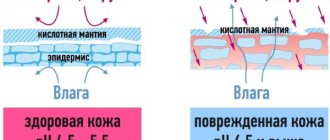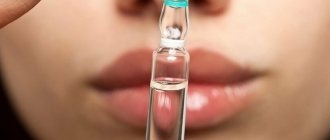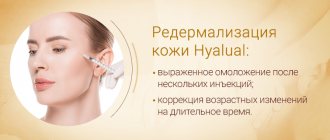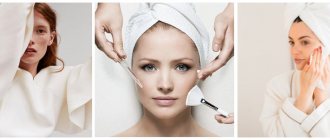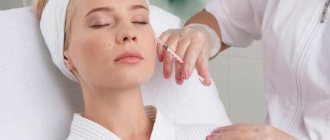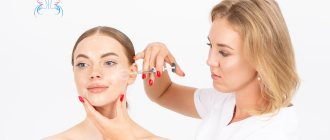What is hyaluronic acid used for? In what procedures is it used?
Non-cross-linked hyaluronic acid is used in cocktails for needle mesotherapy because it quickly decomposes in the dermis, moisturizing it and increasing tension, for example, when used in combination with calcium hydroxyapatite, as well as lightening, in combination, for example, with amino acids.
On the other hand, cross-linked hyaluronic acid, depending on the degree of cross-linking and cross-linking agent, is an excellent material for filling volumetric losses. Such drugs are used for lip augmentation, modeling cheeks, facial contours, chin, and labia. To obtain a beautiful and long-lasting effect in these cases, hyaluronic acid should be injected deeper, that is, subcutaneously or inside fat deposits, or even deeper into the periosteum.
When to start injections?
Our skin cells begin to lose natural hyaluronic acid, alas, starting at the age of 30. Let's talk a little about its role in our body. Hyaluronic acid provides hydration to the tissues of the entire body, metabolism at the molecular level and is responsible for the production of proteins - collagen and elastin, thanks to which our skin is firm and elastic. Hyaluronic acid, in turn, is synthesized by cells called fibroblasts. After 30 years, fibroblasts no longer produce collagen and elastin as efficiently; accordingly, the amount of hyaluronic acid decreases, and the skin begins to lose its youthful appearance. Thus, course biorevitalization procedures can be indicated already from this age. The thought creeps in: the sooner you start doing injections, the longer you will maintain youthful skin, and by the age of 40 your face will look, as they say, like the most appetizing peach in the garden. All you need to do is go and see, you can’t have too much hyaluronic acid…. So, friends, this is a dangerous misconception!
– The principle “the sooner the better” does not work in biorevitalization! Marina Aleksandrovna warns
. – Excessive stimulation of cells can lead to the problem of resource depletion at a certain age. If a girl abuses procedures, by the age of 40 the processes of hyaluronic acid production will be disrupted. After all, what is biorevitalization? We are trying to revitalize our cells and stimulate them to produce quality collagen and elastin. And if we nourish the skin with “light food”, despite the fact that it is not recommended to eat until the age of 30, the skin begins to become lazy. Cells adjust to a different mood: why work if you can do nothing? Therefore, biorevitalization can be used only when your skin really needs additional stimulation and nutrition.
If a cosmetologist sees that the patient has good skin, he will not recommend biorevitalization. Of course, the doctor will select procedures related to skin cleansing and proper care, and may recommend devices such as Dermadrop. But the doctor will not penetrate into the dermis ahead of schedule without indications.
Hyaluronic acid injection – what does the procedure look like?
We perform hyaluronic acid treatments on healthy adult patients. The cross-linked acid is a temporary tissue implant, so the patient should not have any infection. The drug should also not be administered during dental treatment and for at least 2 weeks after its completion.
Hyaluronic acid injection – what the procedure looks like
After examination and consultation, makeup is thoroughly removed from the face, then the skin is disinfected. Depending on your needs, you can apply a numbing cream. Some treatments do not require anesthesia at all, and there are also medications that contain anesthetics. For more precise administration, the doctor marks landmarks on the skin with a special marker pen, this will help achieve an optimal aesthetic effect during the procedure.
Needle mesotherapy involves intradermal injection of a selected cocktail with a needle. Volume replenishment can be done using a needle or cannula.
The amount of preparation depends on the progress of the correction we want to make.
When are hyaluronic acid injections used?
Hyaluronic acid injections are used for general skin rejuvenation, as well as as individual procedures:
- correction of nasolabial folds;
- filling vertical wrinkles above the lips;
- elimination of vertical wrinkles between the eyebrows;
- restoration or giving additional volume to the lips and cheeks.
Hyaluronic acid injections are used to rejuvenate and restore the décolleté, arms and other areas of the body. Depending on the desired result, injections are administered to different depths of soft tissues and skin. Thanks to this cosmetic procedure, it is possible to quickly eliminate wrinkles, even out skin defects, change the shape of the face, the shape of the lips and much more.
How does the lip augmentation procedure with hyaluronic acid work?
Nowadays, lip augmentation with hyaluronic acid is considered one of the most popular treatment methods in the field of aesthetic medicine. Cross-linked acid can be delivered to the lip area in a variety of ways. This corresponds to the effects we want to achieve during treatment.
To correct, for example, asymmetry, a needle and cannula are used. The cannula works well for narrow but symmetrical lips that primarily require adding volume. There are three methods of introducing hyaluronic acid - linear, point and micro. They can also be combined.
Hyaluronic acid result
Filling wrinkles with hyaluronic acid – how does it work?
We use botulinum toxin (Botox) to smooth out fine lines and wrinkles, and once deep wrinkles are eliminated, we can rejuvenate and smooth the skin with hyaluronic acid. It is usually injected linearly, subcutaneously, to “push out” the wrinkle.
Keep in mind that not all wrinkles can be corrected with hyaluronic acid. To remove difficult, deep wrinkles, you need to influence the quality of the skin, using, for example, fractional CO2 laser, mesotherapy or procedures using platelet-rich plasma.
Nose correction with hyaluronic acid – is it possible?
The nose is a part of the face that is of great importance for the perception of appearance, hence the great interest in both plastic surgery and minimally invasive methods of improving its appearance.
The nose can be corrected with hyaluronic acid, but this requires a lot of experience and precision, as well as a sense of aesthetics - sometimes the nose appears more massive after the injection of acid. The most common indications for the use of crosslinked acid in this area are to correct a hump and lift a drooping nasal tip.
Depending on the anatomical situation, acid is injected into the nasal area using a needle or cannula.
How does a hyaluronic acid injection work?
Rejuvenation with the help of this cosmetic product is considered a “friendly” procedure, since hyaluronic acid is a polysaccharide found in many tissues of the body. It is secreted by fibroblasts, but with increasing age, the secretion decreases, which invariably affects the skin.
Gels are produced based on hyaluronic acid, which immediately after being introduced into tissues begin to reconstruct their structure. In this case, all natural processes proceed without change. During the action of the acid, the skin becomes elastic, wrinkles are leveled out and become less noticeable. The skin becomes smooth.
The cosmetic effect of the procedure lasts from 6 months to a year. It depends on the type of skin and its characteristics. The patient’s lifestyle also affects the duration of the effect. Gradually, part of the acid is absorbed, and the rest is excreted from the body as a natural product, without causing irritation or an allergic reaction.
Procedures for rejuvenation with hyaluronic acid
After examination, the rejuvenation procedure is prescribed by a specialist. Injections are injected directly into problem areas where wrinkles and defects are clearly visible.
Types of medical procedures:
- Mesotherapy is a therapeutic procedure for general skin rejuvenation and stimulation of wrinkle smoothing processes. During the procedure, microinjections with hyaluronic acid are injected under the skin of the face.
- Contour plastic surgery – facial contours are corrected and wrinkles are smoothed out. The procedure involves introducing the active substance into problem areas.
- Biorevitalization triggers the restoration of metabolic processes and the regenerating properties of the skin. The procedure is based on the use of hyaluronic acid injections.
The gel fills the voids, while deep folds are leveled and wrinkles are smoothed out. Externally, your face will look younger by about 10 years. This is a safer and less expensive method compared to plastic surgery.
Using injections, you can reinforce the oval of the face. In this case, the cosmetologist introduces hyaluronic acid according to a certain scheme, calculating it depending on the individual person. The composition of the cosmetic preparation, in addition to hyaluronic acid, also includes other substances that differ in the type of effect and duration of the effect.
Long-term fillers are usually 2 types of fillers: collagen and hyaluron. Both of these components are natural substances that are present in the connective tissue of every organism. The validity period of a collagen injection is from 2 to 4 months, hyaluronic acid from 6 to 9 months.
Fillers of a permanent or semi-permanent type are suspensions of tiny particles and a liquid or gel. These injections help eliminate folds and deep-lying facial wrinkles. The duration of the effect can last for 12-18 months.
Hyaluronic acid: course of injections
Preparation for the rejuvenation procedure involves cleansing the skin:
- makeup removal;
- disinfection;
- use of painkillers.
Analgesic creams and topical preparations can be used as a pain reliever. There are often cases when pain relief involves applying a piece of ice to the puncture site. Some cosmetic products contain lidocaine, which eliminates sensitivity during the injection itself. Pain relief is not always required. In some cases, the procedure is painless.
After the preparatory steps, the doctor injects the drug into those places where correction is required. To distribute the filler, the doctor massages the injection site before the substance turns into a gel. In some cases, a cold compress is applied after the procedure to minimize swelling and bruising. The doctor warns that redness and swelling may appear at the injection site, which disappears after a few days. The specialist should warn that after injections of hyaluronic acid you should not:
- be in the sun;
- overheat;
- perform physical activity.
Regularity of repeated injections
After the procedure, swelling appears at the injection site, which gives the impression of a slightly increased result. But this effect disappears after 2-3 days along with swelling. In some cases, bruising may occur; a cold compress will help reduce the likelihood of this and speed up its disappearance.
Injections are valid for 6-12 months, depending on the manufacturer of the drug and its composition. After this period, the drug will completely resolve, and the skin will return to its original appearance. But studies prove that you can achieve the most positive effect if you administer injections after 6-9 months and use special preparations for moisturizing and lifting the skin based on hyaluron.
How does hyaluronic acid work under the eyes?
Cross-linked hyaluronic acid in the eye area is most often injected to correct tear troughs, that is, a depressive condition that occurs in almost every person with age. This is due to the disappearance of fat deposits in this area. But patients must be carefully selected for this procedure, as the acid can be visible through the thin skin of the lower eyelids. The procedure may also worsen lymphedema if a person is prone to it.
In addition, the acid in this area usually takes a long time to work. There are medications on the market that are specifically designed to fill the tear trough.
Interestingly, the aesthetics of the under-eye area is significantly improved by improving the quality of the skin of the lower eyelids. This is one reason why patients struggling not so much with volume loss, but with gray, tired skin, are recommended to undergo a series of CO2 laser or mesotherapy treatments.
Mesotherapy around the eyes before and after
How do injections of hyaluronic acid into the nasolabial folds work?
The hyaluronic acid contained in thick injectable gels is similar to that produced by the human body. It is evenly distributed throughout the tissues without causing rejection or other side effects. Suitable for even such thin, sensitive and delicate areas as the skin of the lips.
Modern drugs can not only remove nasolabial folds with hyaluronic acid, replenishing lost tissue volume. They are also actively used to correct wrinkles in other areas of the face. Improves skin tone and increases its elasticity. Injections of hyaluronic acid stimulate rejuvenation and cell growth and collagen production. The hyaluronic acid filler is distributed throughout the tissues, restoring the natural turgor of the skin.
The drug itself is in a sterilely packaged syringe. By adding volume where it is lacking, hyaluronic acid filler into the nasolabial folds evens out the surface of the skin, as if lifting the wrinkle from the inside.
The results of hyaluronic acid injections are noticeable almost immediately. In the photo before and after the procedure for smoothing nasolabial folds, the difference is visible to the naked eye - significantly smoothed out creases, tightened and moisturized skin.
What are the contraindications to the injection of hyaluronic acid?
Absolute temporary contraindications for treatment with cross-linked hyaluronic acid, that is, for placement of an absorbable implant in the tissue, include:
- pregnancy and breastfeeding;
- any active infections, including colds, urinary tract infections, herpes, etc.;
- active tumor, radiotherapy and chemotherapy;
- poorly controlled hypertension, diabetes, other chronic diseases;
- period 2 weeks before and 2 weeks after dental procedures (including sandblasting, whitening, etc.);
- period of exacerbation of certain autoimmune diseases.
Permanent, absolute contraindications are:
- hypersensitivity to any component of the drug;
- unrealistic expectations regarding the effect of treatment;
- increased tendency to form hypertrophied scars;
- chronic kidney disease at stage 5;
- cirrhosis of the liver;
- AIDS.
How is rehabilitation after treatment with hyaluronic acid? What should the patient do?
In general, you should not massage the treated areas yourself unless your doctor tells you otherwise. The patient should not visit the sauna, swimming pool or gym for a week. After 2 weeks, a follow-up visit is recommended to assess the final effect of treatment. In case of large swelling, the treated areas can be cooled.
The patient should see a doctor if there is pain that does not go away after using over-the-counter pain relievers or if the treated area turns white. In this case, you must immediately inform the doctor who performed the procedure.
Facial mesotherapy. Photos before and after
Hyaluronic acid – complications after incorrectly performed procedures
Contrary to popular belief, hyaluronic acid injections are not completely safe. The greatest risks are associated with incorrect administration of cross-linked drugs. In extreme cases, it can block an artery, leading to necrosis of the skin and deeper structures, and even blindness if the drug moves into the ophthalmic artery or thrombosis of the ophthalmic artery due to obstruction of another vessel connected to it.
Therefore, such procedures should only be performed by a physician in a treatment room with appropriate medications, including hyaluronidase, which, if administered immediately, can prevent the development of the aforementioned tragic complications.
Complications of hyaluronic acid can also be infectious, such as abscess formation or biofilm formation, which should be treated accordingly.
Very rare, but allergic complications occur - from swelling, rash, formation of granulomas to anaphylactic shock. Although usually these are reactions not to the acid itself, but to other components of the drug. To exclude such consequences, the doctor does tests before the procedure.
Pros and cons of filling nasolabial folds with hyaluronic acid
Previously, instead of hyaluronic acid, silicone was mainly used to fill nasolabial folds. It did not dissolve over time. Therefore, one injection was theoretically enough for a lifetime. However, that's where the positives ended. Silicone nasolabial fillers often caused allergic reactions and were rejected by the body. In some cases, the silicone slipped and changed the contours of the face beyond recognition.
The advantage of preparations with hyaluronic acid is not only their effective positive effect on the epidermis, but also their biodegradability. Such fillers are removed from the body without surgical intervention within a certain time - on average 12 months. Hyaluronic acid also has a cumulative effect. Even after its complete removal, nasolabial folds will be less noticeable due to a general improvement in the condition of the skin and stimulation of regeneration processes. Repeated injections will only enhance the positive effect.
Disadvantages include individual intolerance. According to statistics, allergic reactions to preparations with hyaluronic acid occur in only 0.5% of people. Sometimes after injections of hyaluronic acid there is slight swelling and redness at the injection site, but this disappears within a maximum of 5 days.


